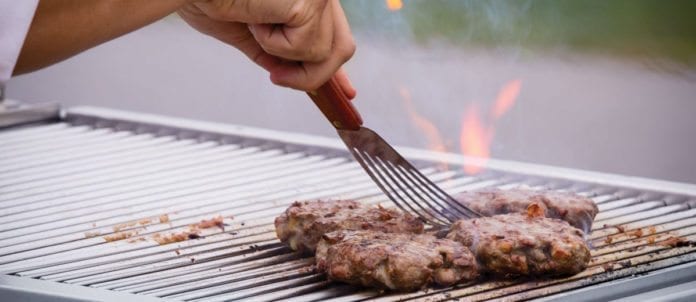Barbecue — possibly humankind’s oldest method of cooking — is experiencing a re-awakening in commercial food operations. And it’s not going low-and-slow. Iconic barbecue, long the domain of high-profile pit-masters in the southern U.S., has been making its way into mainstream restaurants, says Steven Raichlen, James Beard-award winner and author of the best-selling series The Barbecue Bible.
Barbecue is waking up to pit-barrel cookers, salt slabs, new fuel such as almond wood, “caveman” meats, pine and spruce finishing salts, more types of vegetables, rotisserie and “plancha-style” cooking surfaces.
“There’s a resurgence in barbecuing. It’s the outdoor experience, the aromas, the flavour,” says Bill Verity, owner of Crown Verity — a company which got its start in 1991 and supplies stadiums and golf courses throughout Canada and the U.S. with rolling grills, built-in grills, towable grills and a host of barbecue accessories. “There has been a big trend in foodservice in the last five or six years at golf clubs; the members want to have a barbecue every Friday night so the chef might put together a whole outdoor-grilling section with a couple of barbecues.”
TAKING A CUE FROM HOME COOKS
In a reversed order of things, trends in barbecuing and outdoor kitchens are originating from residential backyards and moving into commercial restaurants. Based in Concord, N.H., MagiKitch’n makes commercial-grade gas and charcoal barbecues as well as outdoor-cooking equipment for operators seeking portability and convertibility. “We saw a proliferation of [home cooks]creating these beautiful outdoor cooking spaces and we wanted to come up with a commercial version of that,” says Mark Lang, vice-president of Sales.
Oakville, Ont.-based Tarrison Products Inc., which has been manufacturing serving counters for restaurants for the past 14 years, has seen a shift in interest toward outdoor barbecue kitchens — prompting president Jim Witt to begin making counters rugged enough to be used outdoors. “It’s turned out to be a big item for us in the last number of years,” Witt says, adding the company is about to launch a new website dedicated to professional outdoor kitchens.
The food operations at a hotel, he says, might want a cooking area on the patio — where aesthetics are important — that’s tough but doesn’t look institutional. “It’s a mobile modular system that doesn’t look mobile and modular,” he says.
SMOKE ON THE HORIZON
Chefs are smoking more ingredients than ever before, making it a significant trend, according to Ted Reader, chef, author and instructor at Niagara College. “Chefs are bringing smokers into the kitchen to help diversify their menus and are using a variety of charcoals and woods to add big flavour to foods.”
Just as the boundaries of the barbecue belt are continuing to dissolve, Raichlen says there are signals that smoking is on the rise. “I called 2016 “the year of smoke” and that will continue into 2017.” However, he points out divergences: smoking traditionally uses pork shoulders, briskets and ribs, but it will now also take on vegetables, butter, heavy creams, Hollandaise sauce and desserts. In addition, Michelin-starred fine-dining restaurants are jumping on the smoking bandwagon in what Raichlen calls “Tweezer ’Q ” — using a smoker and a wood-burning grill to prepare refined foods such as pricey Wagyu beef.
Verity says smoking is convenient and efficient: smokers can operate up to 20 hours on one load of charcoal, making it perfect for low-and-slow 18-hour pulled pork. “Restaurants will buy a Primo [ceramic grill] and put it outside and they smoke all kinds of things on it,” he says.
Tom Field, corporate chef at Concord, Ont.-based Alto-Shaam, agrees there has been an increased interest in barbecue and smoking from food operations. And while chefs have been using smokers for more than a decade, new equipment can be programmable, so staff don’t even have to touch the smoker box. “Restaurants are beginning to understand the value of putting the smoker option in their combi oven. They can get a smoker that cleans itself,” he adds.
MAKE THE RIGHT CHOICE
Manufacturers and chefs recommend taking time to determine equipment needs. Pay attention to your horsepower and think about matching your BTUs with your needs, says Lang. “What volume will be going through your venue? Maybe you’re a winery doing catered events here and there compared to a restaurant trying to do 200 covers off that piece of equipment in a two-hour time span.”
The menu dictates equipment choice as well, adds Lang. For example, fatty hamburgers will require grease management. “If you’re smoking or doing butterflied chicken, make sure you can get a temperature setting for a low-and-slow process. Some grills don’t lend themselves to that. There’s too much heat.”
Don’t forget clean-up, he warns, and be sure the equipment is built to be taken apart and vigorously cleaned regularly. “Especially if it’s in an outdoor kitchen and your customers can see it.”
Field recommends thinking ahead about what you want to do with the equipment. “It used to be that people would say they’d never use a smoker,” he notes, adding that talking with operators that do a lot of smoking before you purchase is helpful. “Now, with barbecue being so popular, more cooks see the possibilities of the technique.”
Volume 49, Number 12
Written By Andrew Coppolino


















